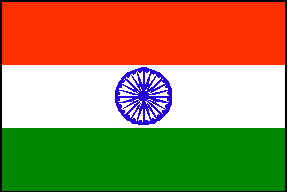India
India is a large country with the second biggest population in the world and many different languages, cultures, religions and climates.
India India is a large country with the second biggest population in the world and many different languages, cultures, religions and climates. |
|
|
India's
People When Indian people greet each other they place their hands together and say "Namaste". This means, "I bow my head to you." Older people are treated with great respect in India. When greeting an elder, some Indians may touch their feet as a sign of respect. India's people come from many backgrounds. Some are very wealthy while others are very poor. Most people live modestly in the large cities. Religion is very important in the culture of India. Most people are Hindu or Muslim, but Christianity, Sikkhism, and Buddhism, and other religions are also practiced. Clothing in India varies by area. Most women wear a sari made of colorful silk or cotton. The sari is one long piece of material that is draped around the body like a dress. Many men wear a dhoti. A dhoti is a white piece of cloth that is wrapped around the hips and pulled through the legs. Not all people dress traditionally in India, but the clothing is always loose due to the heat. Most children in India attend school. Some schools are modern and have books and computers. In poor areas of the cities or in remote areas, there can be 40-60 students in one classroom with little or no supplies. Most schools teach in English because there are too many regional languages. India's Homes |
| India's
Culture The people of India have many languages, religions, and cultures. Religion has been very influential in the music, dance, festivals, and clothing of India. The unique sound of India's music is often created with an Indian instrument called a sitar. This instrument looks similar to a guitar, except that it has a very long neck. There are 18 official languages, but over 1,600 languages and dialects spoken in India. English is commonly spoken in India. |
|
India's
Foods Many of India's people are vegetarians, meaning they don't eat meat. Hindus believe that the cow is a sacred animal and never eat beef. Much of the food in India is flavored with spices such as cinnamon, garlic, and cumin. Most meals include rice, vegetables, bread, and yogurt. |
| India's Activities Watching movies is a popular pastime in India. Bombay is the center of India's film industry. Indian children play soccer and badminton and board games like Parcheesi and backgammon. Basketball is becoming more popular in recent years. India's
Animals
|
|
India's
Holidays and Celebrations Diwali is a joyous celebration that takes place on the last day of the last month in the lunar calendar. This is usually at the end of October. During this five day holiday, people light oil lamps and set off fireworks. The holiday is also to worship the goddesses Kali and Lakshmi. People thank them for their good fortune and strength. Diwali is also the beginning of the new year. It is a time for people to reflect on the importance of their lives. They begin the new year with good habits. |
| India's Land India has the second largest population in the world. The land of India has many forms including plains, mountains, and tropical areas. The climates change so much in India that India is said to have three seasons- the hot, the wet, and the cool.India's Cities and Landmarks Calcutta is one of the most populated cities in the world. It is home to more than 10 million people. Monsoons can bring so much rain to Calcutta that the city can be flooded for months. India's cities are a unique mix of modern and traditional ways of living. The busy streets of the city are crowded with buses, taxis, and cars as well as rickshaws (a type of cart drawn by person or bike) and sometimes camel, cows, or other livestock. Only a small percentage of people in India own a car. Buses, trains, and walking are the primary ways people travel in India. The Taj Mahal is a popular tourist destination in India. It is also one of the most famous buildings in the world. The white marble monument was built by a 17th century ruler as a gift to his wife.
|
|
 |
India's
Facts: Area: 1,269,346 sq. miles Capital City: New Delhi Population: 1 billion Main Languages: Hindi, English, and Urdu Currency: Rupee Products: rice, wheat, oilseed, cotton, jute, tea, sugarcane, potatoes; cattle, water buffalo, sheep, goats, poultry
|
References:
All images from Microsoft Office Clip Art and Gallery licensed through Microsoft Front
Page and Microsoft.
Map images from Lonely Planet, http://www.lonelyplanet.com
Graham, Leland and Brandon, Traci. A Trip Around the World.
North Carolina: Carson-Dellosa Publishing Company, 1996.
Graham, Leland and Brandon, Traci. Another Trip Around the World. North
Carolina: Carson-Dellosa Publishing Company, 1996.
Adams, Ganeri, and Kay. The DK Geography of the World. New York: DK
Publishing, 1996.
Please do not copy information, text, or images from this site without
permission.
Copyright 1999-2003.